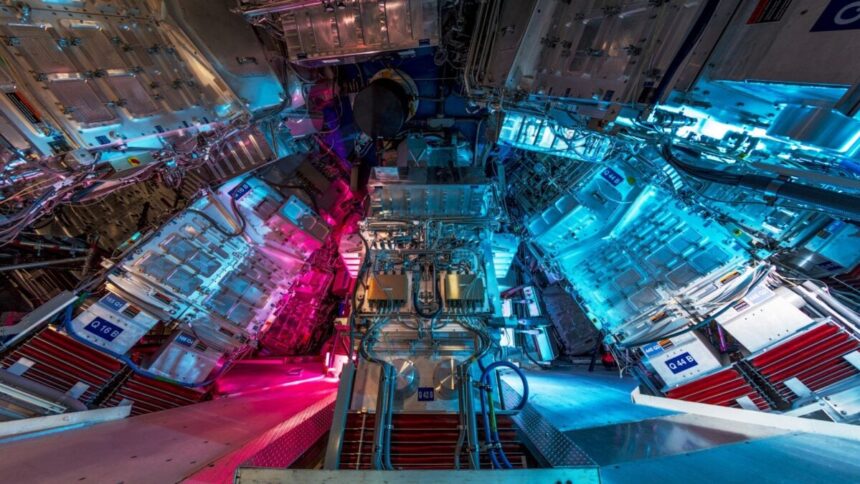AI is giving a huge efficiency boost to one of the biggest nuclear fusion facilities in the world—but perhaps not in the way you think.
In research published today in Science, scientists at Lawrence Livermore National Laboratory report how its newly developed deep learning model accurately predicted the results of a 2022 fusion experiment at the National Ignition Facility (NIF). The model, which assigned 74% probability for ignition in that experiment, outperforms traditional supercomputing methods by covering more parameters with greater precision.
“What we’re excited about with this model is the ability to explicitly make choices for future experiments that maximize our probability of success each time,” study co-author Kelli Humbird told Gizmodo during a video call. Even a facility as large and well-established as the NIF can only “do a couple dozen of these ignition attempts per year—so really not very many at all, given how much territory we have to cover,” added Humbird, who leads the Cognitive Simulation Group at NIF’s Inertial Confinement Fusion Program.
Currently, nuclear power plants run on nuclear fission, which captures the energy generated by the splitting of heavy atoms, like uranium. Researchers eventually want to shift toward nuclear fusion, a process that combines lightweight hydrogen atoms to release massive amounts of energy. Fusion produces more energy and doesn’t create harmful, radioactive byproducts, so having fusion as a reliable source of energy would greatly benefit our society’s transition to sustainable energy. Although the field has made some promising advances, the consensus is that we’re still far from implementing nuclear fusion on a commercial scale.
NIF’s fusion experiments are laser-driven. First, the lasers heat up a gold cylinder called the hohlraum, which then emits a flow of powerful X-rays. The extreme temperatures compress the fuel pellets containing deuterium and tritium, two hydrogen isotopes used in fusion experiments. In an ideal scenario, this triggers enough deuterium-tritium fusion reactions to produce more energy than the lasers consume.
Computer simulations can’t reliably predict all the physics in this process, Humbird said. That’s in part because the codes are often simplified so they’re “computationally tractable,” but the simulations themselves can also introduce some errors. Even if you’ve taken all sorts of precautions, it still takes days for the computers to finish running through the code, she added.
Achieving nuclear fusion is like scaling a tall, uncharted mountain, Humbird said. The computer simulations are like an “imperfect” map that’s supposed to teach researchers how to reach the peak—but this map could be rife with errors that may or may not be the product of their research design. Meanwhile, the clock is ticking, and researchers have to quickly decide whether they’ll take the hike that day and which tools they’re going to use. And of course, each “hike,” or ignition attempt, burns a huge hole in the budget.
And so, Humbird’s team embarked on a mapmaking quest, stitching together “previously collected NIF data, high-fidelity physics simulations, and subject matter expert knowledge” to build a comprehensive dataset. Then, they uploaded the data to state-of-the-art supercomputers, which ran a statistical analysis lasting over 30 million CPU hours.
“What we basically came up with was a distribution of things that go wrong [at] NIF,” Humbird explained. “All of the different ways that we have observed implosions. Sometimes the laser doesn’t fire exactly how you asked it to. Sometimes your target has defects in it that can cause things to not go super well.”
The model allows researchers to preemptively determine the efficacy of their experimental design, saving them considerable time and money. Humbird used the model to assess their own design from a 2022 experiment, which accurately described the results of the specific run in advance. In particular, Humbird was pleased to see that subsequent tweaks to the model’s physics increased the accuracy of its predictions from 50 to 70%.
For Humbird, the strength of the new model is that it accepts and replicates the imperfections of the real world—whether that’s a flaw in the instrument, research design, or just some silly trick of nature. At the same time, it’s a reminder that, while quick progress is exciting, things often take a lot of time and will even result in outright failure.
“People have been working on fusion for decades… We shouldn’t be so bummed about the times things don’t work,” Humbird said. “The fact that we sometimes get 1 megajoule of yield instead of two shouldn’t upset us, because not too long ago we were only getting 10 kilojoules. It’s a huge step forward for research, and hopefully a huge step forward for clean energy in the future.”
Read the full article here












